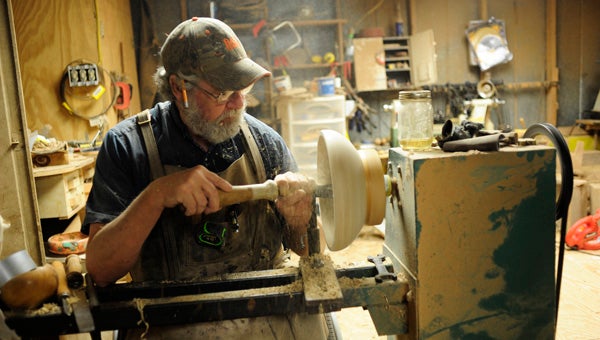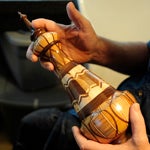
By Scott Mims
Ben Smith loves to build things out of wood.
Vases, bowls, spheres—you name it, and Smith has probably built some version of it. But to call one of his pieces simply a “vase” or a “bowl” would not do it justice. A close look at the fine detail and complexity of his designs shows the work of a true craftsman.
Pieces of hollowed-out hickory nuts line the outside of some pieces, creating a pattern from their natural shapes. Smith spent four days making just a decorative ring for a bowl containing ambrosia maple, cedar, walnut and mulberry.
Other pieces of his work defy description, and stand alone as works of art.
Smith, 63 of Jemison, like his father and grandfather before him, is a journeyman carpenter. He has been around woodworking for as long as he can remember, and recalls as a kid playing with wooden blocks left over from his father’s projects.
“I thought I was just the luckiest kid in the world, but all along he was grooming me to be a woodworker,” Smith said of his father. “That’s what I’ve always done. He intended for me to be a carpenter.”
Smith started working in a cabinet shop doing general cabinetwork. Then he took a job as a journeyman carpenter with RC&G, and later with Brice Building Co. in Birmingham, where he worked for 24 years and was never once laid off.
Smith would still be in carpentry if not for a 1996 bow-hunting accident that left him wheelchair bound. But that hasn’t stopped him from doing what he loves.
“I’d rather be out there in the shop,” he often says, sometimes even getting up in the middle of the night to work on projects.
“I love it. I have told my wife, ‘It called me,’” he said.
Smith sells his pieces at art shows, but he spends little on materials. Most of his investment is in time and energy. The materials are mostly from local trees brought to him by friends and acquaintances.

“I’ve never bought a piece of material,” Smith said.
The process Smith uses is called “segmented turning.” As opposed to traditional woodturning, in which a single piece of wood is used to construct a piece—thereby limiting its design to the size, grain pattern and color of that piece—segmented turning utilizes many pieces and types of wood glued together to form a design limited only by imagination, skill and patience. A single project can contain thousands of individual pieces of wood.
In woodturning, a piece is rotated on a lathe, a machine tool that performs various operations such as cutting, sanding and drilling. As the piece rotates, hand tools are applied to the piece to create a symmetrical object.
Smith’s first segmented piece was a “Rebecca vase” made from a wooden pallet. His favorite piece was an “Indian blanket vase” made from dogwood and many other types of wood.
He has also made genie bottles and balls, or spheres, including a soccer ball. The soccer ball consisted of 12 pentagons and 20 hexagons and was one of the most demanding pieces Smith has ever made, because of the preciseness required to form a spherical shape.
“They have to be absolutely perfect,” he said.
Obviously, Smith’s math skills are showcased in his work.
“I did better at arithmetic than anything else,” he recalled from his school days.
There are several steps to making a segmented wood piece. First, Smith must figure out what types of wood to use. Once the wood is cut up on the band saw, it must be dried. Then, to create a bowl, for example, the pieces are cut into rings and stacked together. All this must take place before a piece can be sanded and finished.
Several of Smith’s pieces, some of them unfinished, are on display at the Chilton County Arts Council building on Second Avenue North in Clanton. Smith is a member of the arts council and travels to art shows around the state.
“It’s good for Chilton County, I think,” he said of the council.
When asked about his most popular seller, Smith declined to list anything, because of the uniqueness of each individual piece.
“They’re one of a kind,” he said.
Awards Smith has won include:
•Leeds Folk Festival, Best of Show 2011
•Fountain City Arts Festival (Prattville), People’s Choice 2011
•Wetumpka River and Blues Festival, Mayor’s Choice 2012
•Leeds Folk Festival, Second Place 2012
•Fountain City Arts Festival, Best of Show 2013
•Art in the Gardens (Aldridge Gardens, Hoover), First Place 2013
•Wetumpka River and Blues Festival, Best of Show 2013
Smith and his wife, Mary Ann, have three adult children, four grandsons and one granddaughter.
His granddaughter has shown an interest in woodworking, and even made a wooden ball in her grandfather’s shop.Lo
